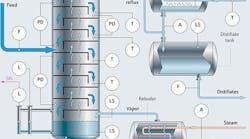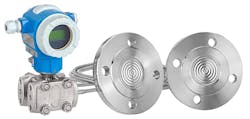Rethink Distillation Column Pressure Measurement
Process requirements dictate the desired pressure profile within a distillation column. Not maintaining the correct pressure at all points can lead to energy waste, inefficient operation that can cause product loss and quality problems and, in some cases, even safety issues. That’s why pressure measurement is one of the most critical parameters for control of distillation processes — and why a column typically has multiple, and sometimes redundant, sensors to measure pressure in various zones (Figure 1).
To maintain the desired pressure profile, the pressure instruments must work safely and reliably. This requires proper selection, calibration and maintenance. So, in this article, we’ll discuss issues found when measuring pressure in distillation columns and review options, selection criteria and safety.
First, let’s set the stage by providing some background about common challenges.
Figure 1. A distillation column usually requires a number of pressure sensors (P) at various locations.
The output from a pressure sensor in a column normally goes to a ground-level pressure transmitter via an impulse line or a remote diaphragm seal with capillary tube. This impulse line or capillary tube may run a long distance — say, from the top of a 100-ft tower to ground level — to get to the transmitter.
The transmitter usually is located in an enclosure to protect it from ambient conditions. However, the capillary tube often is exposed to the environment and, therefore, faces temperature variations.
Ambient temperature changes from day to night and from one season to the next affect the density of the fill fluid in an impulse tube or capillary. These fluctuations, in turn, negatively impact the reliability of the pressure measurement because pressure transmitters by design assume the density of the fill fluid in a remote capillary leg is constant.
The transmitter interprets these variations not as changes in fill fluid density but rather as changes in pressure. If not properly accounted for, these fluctuations can result in significant measurement deviations, posing problems to the reliability and safety of the process.
Typical ways to counter these fluctuations with traditional remote diaphragm seal configurations range from insulating or heat-tracing the tubes to installing critical distillation columns in climate-controlled buildings.
These options are costly to implement and maintain and, therefore, typically aren’t considered acceptable methods for handling ambient-temperature-related drift. Fortunately, new manufacturing methods for remote diaphragm seals address these ambient-temperature-related issues, as we’ll discuss below.
Tough Environment
Most distillation columns operate under vacuum conditions for greater efficiency and lower energy consumption. Some processes require high temperature as well. Vacuum service combined with high temperatures can present many challenges to pressure instrumentation.
Deformation of diaphragm seals and flanges may let atmospheric air enter the vacuum column. Extreme expansion of the fill fluid in remote seal systems can cause seal failure and, in severe cases, allow release of chemicals through damaged flanges and seals, posing potential plant safety issues. Seal damage also can result in fill fluid leaking into the process, which can keep products from meeting specifications.
Vibration of the column can cause damage, intensified by mounting issues such as close-coupling to the vessel. Thermal shock poses another potential issue, particularly when the transmitter is mounted too close to the column due to short capillary lengths.
To counter these problems, pressure instrumentation suppliers have developed three improvements: • asymmetrically flexing diaphragms in remote seals; • better seal fluid filling techniques; and • elimination of impulse tubes and capillaries.
Asymmetrically flexing diaphragms. A conventional diaphragm on a remote seal moves symmetrically when pressure is applied and has a high degree of stiffness. This requires thinner or larger diameter diaphragms to provide adequate measurement sensitivity — making the diaphragm seal more susceptible to impact from process or ambient temperature changes.
When using remote diaphragm seals with oil-filled capillaries, the common practice is to specify the largest process connection possible and allowable per process requirements to reduce the impact of temperature-induced errors on the measurement. With conventional diaphragms, the thermal error for a 2-in. flange is three times greater than that of a 3-in. one. Often, facilities install concentric reducers or other such adapters to increase the size of remote seals to improve measurement reliability.
Some manufacturers of diaphragm seal systems now offer seals that flex asymmetrically in opposite directions around the center point. This results in a seal that flexes predictably with good repeatability while using less fill fluid. It allows for thicker diaphragm seals that provide greater durability but still maintain the sensitivity required for adequate turndown.
This technology significantly reduces thermal errors, even while using smaller remote seals. For example, a 2-in. flange with an asymmetric membrane provides better measurement stability and faster recovery from thermal shocks than a 3-in. flange with conventional diaphragms.
Better seal fluid filling techniques. Recently, some manufacturers have adopted new filling processes to address temperature issues. This is because the diaphragm seal, capillary and transmitter is a closed system that never must be opened. Otherwise, fill fluid can escape and adversely impact temperature and response time effects.
In these new processes, the fluid is filled under deep vacuum conditions similar to standard procedures. However, the amount and type of fill fluid now is pre-determined for each seal system — that is, the instrument supplier fills the seal system with fluid to meet the specific temperature and environmental requirements of the particular application. The amount of fluid is measured to ensure the device is filled completely.
Because the fill fluid is closely controlled and chosen for the specific application, it is less susceptible to temperature changes.
Elimination of impulse tubes and capillaries. Instrument makers now offer pressure sensors with a digital output (Figure 2). The sensor measures gauge or absolute pressure and sends signals back to a pressure transmitter electronically. For example, the Endress+Hauser FMD72 uses a 4–20-mA HART loop to connect two pressure sensors to the transmitter. The 4–20-mA loop provides enough power for the analog-to-digital converter in each sensor to change the pressure signal and impose it onto the 4–20-mA signal, along with status and diagnostic information.
Figure 2. Sending measurements electronically eliminates the need for an impulse line or capillary tube.
Selecting Pressure Sensors
In choosing a pressure sensor for installation in a distillation column, you must focus on achieving reliable and safe measurements. Commonly considered criteria include:
• Measurement span. For better accuracy and to accommodate future pressure range changes, select a span 25% greater than the pressure range, if possible.
• Material of construction. Ensure that diaphragm seals and other wetted parts of the measuring cell are compatible with the process flange’s material. At a minimum, choose stainless steel. Depending on the chemicals involved, you may need exotic materials, such as high-nickel alloys or even platinum or gold.
• Measuring cell fill fluid. Consider the temperature range both of the process and ambient environment as well as the presence of vacuum conditions. Consult with the pressure sensor manufacturer to select a suitable fill fluid for the measurement cell and for any impulse tubes or capillaries used.
• Flushing rings. Order these with diaphragm seals wherever possible and allowable to provide a means to clean diaphragms without removing remote seals from the process.
Reassess Your Choices
Pressure is one of the most common variables measured in distillation processes. Pressure sensors with remote diaphragm seals often provide measurements in such applications and are considered reliable and safe. However, such systems are prone to issues related to ambient temperature that can adversely affect both reliability and safety.
Typical methods to address temperature effects on measurement are costly and maintenance-intensive. However, recent developments in remote seals, seal-filling methods and electronic transmission of pressure signals helps minimize these problems to provide more reliable pressure measurements.
DANIEL SIDDIQUI worked for Endress+Hauser, Greenwood, Ind., when this article was written. EHREN KIKER is product marketing manager for pressure and temperature products at Endress+Hauser. Email him at [email protected].




